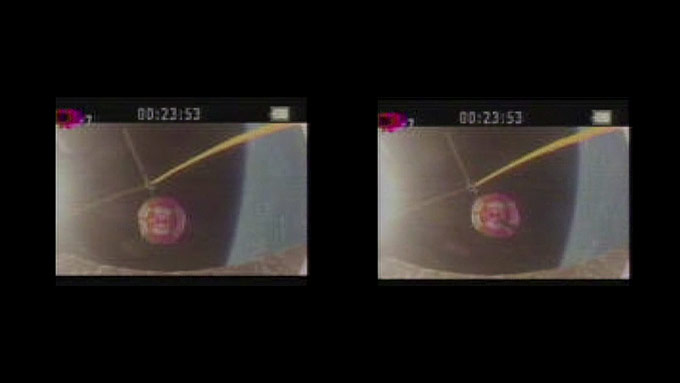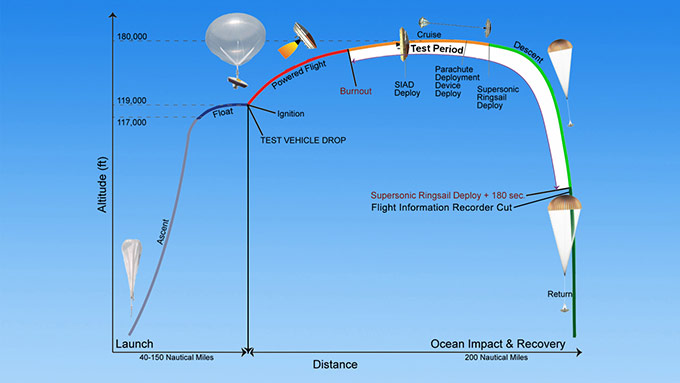
One day after a supersonic parachute crafted to land robots on Mars failed on a test flight high above Hawaii, NASA officials said Tuesday a jackpot of high-resolution video recordings and other data from the otherwise successful experiment should lead to design improvements.
Monday’s test flight 180,000 feet over the Pacific Ocean offshore Kauai proved out several pieces of a next-generation braking system that will help heavier payloads land safely on Mars.
“We conducted a difficult and complex supersonic experiment in Earth’s stratosphere, and it was a successful conduct of that experiment,” said Mark Adler, program manager for NASA’s Low-Density Supersonic Decelerator project at the Jet Propulsion Laboratory. “But the most obvious result of that experiment was a parachute that did not survive much past inflation.”
Without the parachute, the 20-foot-wide test vehicle’s impact with the Pacific Ocean damaged the craft. But managers told reporters Tuesday that recovery teams plucked the vehicle from the ocean, along with its parachute and a suite of cameras and data recorders that documented the test flight.
A quick look at grainy video streamed back to Earth during the test live showed the red and white parachute deploy and initially inflate as designed. A second later, the chute ripped apart in the supersonic air flow flying more than twice the speed of sound.
“A preliminary look at our loads data indicate that the parachute developed full, or nearly full, drag up to the point where that damage can be observed,” said Ian Clark, the experiment’s principal investigator at JPL.
Scientists focused on two video frames from imagery captured by on-board cameras showing the parachute just before and just after it started failing.
“It shows what looks to be a largely, if not fully, intact parachute at full inflation,” Clark said. “In the next frame, you begin to see a radial tear develop, and after that the parachute just cannot survive the supersonic environment any further.”
Despite the parachute’s failure, NASA touted the experiment as a success.
“Once we successfully recover the data from the recorder and the data cards, the team will have met the success criteria for this flight,” said Steve Jurczyk, head of NASA’s space technology mission directorate.
The data cards on the vehicle contain detailed information on the loads, pressures and accelerations experienced during the flight. They also hold vital ultra-sharp video to illustrate exactly what happened when the parachute deployed.
The testbed beamed back low-quality video to the ground in real time.
“Like any science experiment, it is successful if you were able to conduct the experiment, get the data you were looking for, and then be able to make conclusions from that data,” Adler said Tuesday. “In the sense it was not successful, is that we had a parachute that did not survive inflation, so we are now going to have to look at that data and see why that happened and repair that — remedy that — and try it again and get a parachute that is able to survive through the entire event.”
An inflatable ring-like airbrake functioned as expected after a giant helium balloon and an Orbital ATK Star 48 rocket motor boosted the flying saucer-shaped testbed into the stratosphere, where the air is thin enough to mimic the rarefied conditions landers encounter at Mars.
The prototype landing craft reached a top speed four times the speed of sound, and the inflatable doughtnut-shaped braking ring and a ballute — a drag device mixing design elements from a balloon and a parachute — slowed the vehicle to approximately Mach 2.35 for the unfurling of its 100-foot-diameter parachute.
Monday’s flight was the second straight parachute failure for the $230 million program. A similar test in June 2014 had a parachute shred at deployment.
Engineers changed the parachute from a disksail to a ringsail design and added more high-strength Kevlar to the chute in hopes of resolving last year’s problem.
“I think, last year, once we had access to the high-resolution imagery data, we saw the parachute be damaged very, very early in the inflation process,” Clark said. “This year, with the low-resolution data that we have presently, it looks like the parachute remained largely intact, if not entirely intact, up to the point of full inflation. We also saw more drag being generated out of this parachute this year than we did last year, so those are both pluses.”
NASA has one more balloon-borne test flight from the U.S. Navy’s Pacific Missile Range Facility in Hawaii set for next year to continue testing the Mars descent system, plus another round of ground tests using rocket-powered sleds in the California desert.

NASA says the new braking technologies will more than double the mass of payloads future robotic missions could deliver to the Martian surface. Mountainous regions of Mars unreachable by previous landers could also be in play when the new descent system comes online.
“For a 5-metric ton class payload to the surface, this technology can very well enable that,” Jurczyk said.
For comparison, NASA’s Curiosity rover — the largest spacecraft ever to land on Mars — weighed about a metric ton, or approximately 2,200 pounds.
Sending astronauts to the red planet’s surface will take more development.
“To land 20 metric tons-plus for human-class missions, it’s going to take a combination of technologies — maybe hypersonic inflatable decelerators, deployable decelerators … parachutes are definitely an option, as well as ballutes, supersonic retropropulsion, and propulsive deceleration,” Jurczyk said.
Adler said NASA wants to see two successful tests of the braking system before approving the technologies for Mars missions. With Monday’s flight, the inflatable doughnut-shaped airbrake and ballute device passed that hurdle, but NASA could order a fourth balloon launch to finish validating the new parachute, which is the first of its kind developed since the 1970s.
“We very much want to have these failures occur here in our testing on Earth rather than at Mars,” Adler said. “So it’s a success in that we’re able to understand and learn more about the parachutes, so we can get confidence and have highly reliable parachutes for when we have a large mission going to Mars, where we can’t do anything about it.”
Email the author.
Follow Stephen Clark on Twitter: @StephenClark1.



